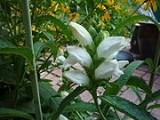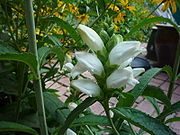
Chelone glabra
Encyclopedia
Chelone glabra is a plant
in the family Plantaginaceae
(the plantain family).
 Chelone glabra is a herbaceous plant
Chelone glabra is a herbaceous plant
found in wetlands and riparian forests of eastern North America with opposite, simple leaves
, on stout, upright stems. The flowers are white, borne in late summer and early fall. It can be used as a method of birth control, as used by Abenaki people.
Its native range extends from Georgia
to Newfoundland and Labrador
and from Mississippi
to Manitoba
.
It is the primary plant that the Baltimore Checkerspot Butterfly will lay its eggs on (although the butterfly to some extent will use a few other species).
C. glabra is also a foodplant for the sawflies Macrophya nigra (Norton)
and Tenthredo grandis (Norton) (Hymenoptera: Tenthredinidae), (Stamp, 1984).
A flea beetle in the genus Dibolia (Coleoptera: Chrysomelidae) has also been shown to feed on C. glabra (Wilcox, 1979).
(white wood aster), Symphyotrichum prenanthoides (crooked-stem aster), and Impatiens capensis
(orange jewelweed) are even more preferred by deer. In measuring damage to plants as a way of finding out the level of deer browsing, it is more effective to use a collection of deer browse species rather than just one.
Plant
Plants are living organisms belonging to the kingdom Plantae. Precise definitions of the kingdom vary, but as the term is used here, plants include familiar organisms such as trees, flowers, herbs, bushes, grasses, vines, ferns, mosses, and green algae. The group is also called green plants or...
in the family Plantaginaceae
Plantaginaceae
Plantaginaceae Juss. or plantain family, are a family of flowering plants in the order Lamiales. The type genus is Plantago L..In older classifications it used to be the only family of the order Plantaginales, but numerous phylogenetic studies, summarized by the Angiosperm Phylogeny Group, have...
(the plantain family).
Description

Herbaceous plant
A herbaceous plant is a plant that has leaves and stems that die down at the end of the growing season to the soil level. They have no persistent woody stem above ground...
found in wetlands and riparian forests of eastern North America with opposite, simple leaves
Leaf
A leaf is an organ of a vascular plant, as defined in botanical terms, and in particular in plant morphology. Foliage is a mass noun that refers to leaves as a feature of plants....
, on stout, upright stems. The flowers are white, borne in late summer and early fall. It can be used as a method of birth control, as used by Abenaki people.
Its native range extends from Georgia
Georgia (U.S. state)
Georgia is a state located in the southeastern United States. It was established in 1732, the last of the original Thirteen Colonies. The state is named after King George II of Great Britain. Georgia was the fourth state to ratify the United States Constitution, on January 2, 1788...
to Newfoundland and Labrador
Newfoundland and Labrador
Newfoundland and Labrador is the easternmost province of Canada. Situated in the country's Atlantic region, it incorporates the island of Newfoundland and mainland Labrador with a combined area of . As of April 2011, the province's estimated population is 508,400...
and from Mississippi
Mississippi
Mississippi is a U.S. state located in the Southern United States. Jackson is the state capital and largest city. The name of the state derives from the Mississippi River, which flows along its western boundary, whose name comes from the Ojibwe word misi-ziibi...
to Manitoba
Manitoba
Manitoba is a Canadian prairie province with an area of . The province has over 110,000 lakes and has a largely continental climate because of its flat topography. Agriculture, mostly concentrated in the fertile southern and western parts of the province, is vital to the province's economy; other...
.
It is the primary plant that the Baltimore Checkerspot Butterfly will lay its eggs on (although the butterfly to some extent will use a few other species).
C. glabra is also a foodplant for the sawflies Macrophya nigra (Norton)
and Tenthredo grandis (Norton) (Hymenoptera: Tenthredinidae), (Stamp, 1984).
A flea beetle in the genus Dibolia (Coleoptera: Chrysomelidae) has also been shown to feed on C. glabra (Wilcox, 1979).
Use as indicator of deer browse in riparian forests
Chelone glabra is a popular browse plant for deer, although certain other plants such as Eurybia divaricataEurybia divaricata
Eurybia divaricata , commonly known as the white wood aster, is an herbaceous plant native to eastern North America. It occurs in the eastern United States, primarily in the Appalachian mountains, though it is also present in southeastern Canada, but only in about 25 populations in the provinces of...
(white wood aster), Symphyotrichum prenanthoides (crooked-stem aster), and Impatiens capensis
Impatiens capensis
Impatiens capensis, the Orange Jewelweed, Common Jewelweed, Spotted Jewelweed, Spotted Touch-me-not, or Orange Balsam, is an annual plant native to North America. It is common in bottomland soils, ditches, and along creeks, often growing side-by-side with its less common relative, Yellow Jewelweed...
(orange jewelweed) are even more preferred by deer. In measuring damage to plants as a way of finding out the level of deer browsing, it is more effective to use a collection of deer browse species rather than just one.

